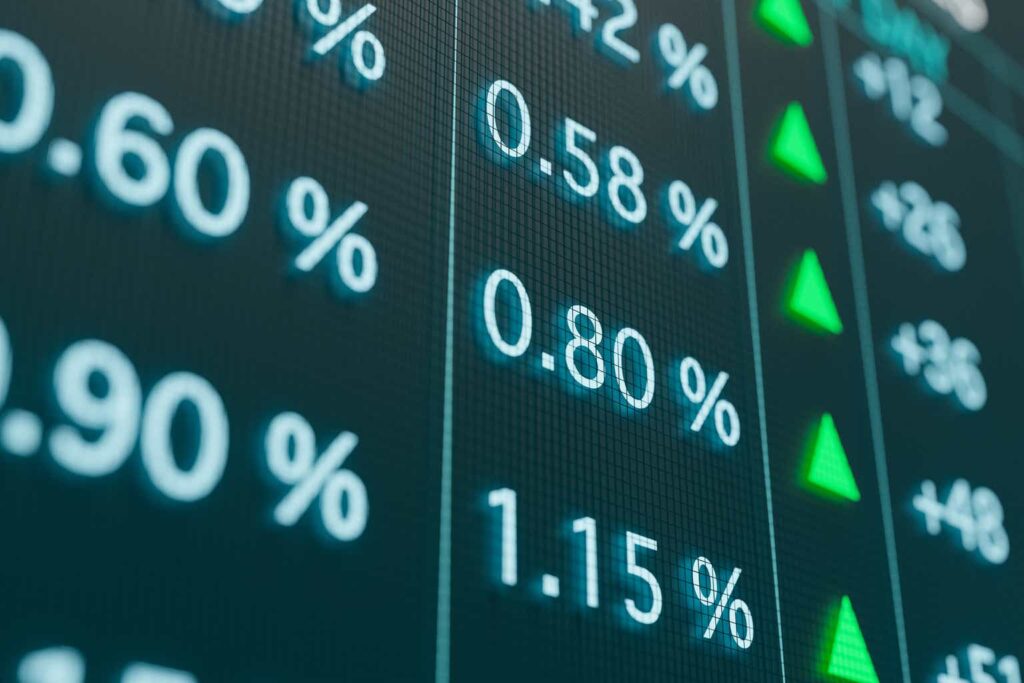Investment Thesis
I believe S&P Global Inc. (NYSE:SPGI) stock is a hold at the current juncture. In my opinion, the credit rating industry in 2023 is influenced by diverse economic factors, mixing optimism with existing uncertainties. S&P Global (SPGI) with its well-known brand and broad global reach, appears poised for long-term growth and stability due to its oligopolistic market structure. The merger with IHS Markit is a notable step, likely to increase revenue, bring about cost synergies, and introduce new product lines, aiming for stronger market leadership. However, the projected 5-year stock price Compound Annual Growth Rate of 5% for SPGI seems less appealing when compared to the 5-year U.S. treasury bond yield of 4%. In my view, this comparison might prompt investors to weigh the relative growth and risk between SPGI’s stock and the safer return from a treasury bond.
Company Overview
In my opinion, S&P Global’s expansive range of services across different segments underlines its robust position in the market, catering to a diverse set of needs in the financial sector. The company’s dominance, especially in the Ratings segment, showcases its critical role in global financial markets. However, the presence of strong competitors like Moody’s (MCO) and Fitch Ratings keeps the competitive landscape quite challenging yet stimulating for S&P Global.
Furthermore, the competition extends beyond traditional credit rating services to other market intelligence and financial data services, with firms like Bloomberg and Thomson Reuters (TRI). In my view, this multi-dimensional competition might push S&P Global to continuously innovate and enhance its service offerings to maintain or improve its market standing. Also, the near oligopolistic structure of the credit rating market, as seen in the significant market share held by S&P Global and Moody’s, reflects a high barrier to entry, which in my opinion, could provide a substantial competitive advantage to these established players over new entrants or smaller firms. The consolidation of market share among the “Big Three” credit rating agencies might also, in my opinion, lead to a stable market environment, although it could be seen as a limitation for fostering more competition and innovation in this sector.
Economic Influences on Credit Ratings in 2023
In my view, the credit rating industry in 2023 is shaped by various economic dynamics. On the upside, I believe that the macroeconomic environment shows promising signs, especially with the substantial alleviation in global supply chains. This, in my opinion, provides a breath of fresh air to industries, enhancing the broader economic picture. Looking at the equity markets, there appears to be a significant trend with more investors moving from active to passive strategies. I interpret this as a possible stabilization in how investments are approached. The bond and credit markets, as I see it, depict a positive image with a decline in corporate cash balances, possibly signaling a surge in corporate investments or a drive towards settling debts. Furthermore, I’m optimistic about the commodity markets, primarily because of the ongoing energy transition for a greener future, which in my estimation, suggests a move towards a more secure and eco-conscious investment terrain.
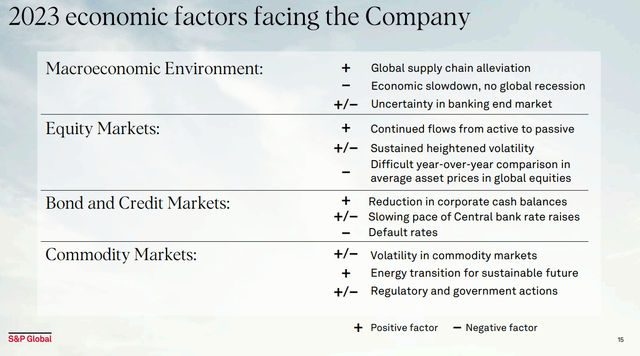
S&P Global Q2 2023 Investor Presentation
On the flip side, there are elements that raise concerns. While the global economy is experiencing a slowdown, I’m relieved to note that it hasn’t morphed into a full-blown recession. However, the uncertainty clouding the banking end market, owing to geopolitical and economic upheavals, is something that, in my perspective, adds a layer of complexity to credit rating evaluations. Equity markets, I observe, are grappling with challenges, especially when making year-over-year asset price comparisons. In the realm of bond and credit markets, I sense a tension arising from the decelerating pace of Central bank rate increments and a worrying uptick in default rates. Lastly, I believe that the unpredictability introduced by commodity market fluctuations and governmental interventions casts a shadow of doubt over the future trajectory of the credit rating industry.
S&P Global’s Sustainable Competitive Advantage
S&P Global has a competitive advantage in the credit rating industry, supported by its recognized brand that attracts demand for its ratings and reinforces the quality of its ratings over time, targeting long-term growth. Operating in a near oligopoly with Moody’s and Fitch Ratings, S&P Global and Moody’s together hold a large share of the global credit rating market, estimated around 95%. This market structure gives S&P Global a level of market power, helping maintain a strong position in the industry. Moreover, S&P Global’s global reach enhances its competitive advantage, allowing the corporation to capture a larger market share and gain insights into market trends and developments across different regions. This global footprint aids S&P Global in delivering more comprehensive ratings and analyses.
The credit rating industry, largely dominated by the “Big Three” – S&P Global, Moody’s, and Fitch Ratings, operates within a structure often termed as a “toll bridge” moat. This signifies the essential nature of the services provided by these agencies. When companies need credit ratings, a requirement for accessing capital markets or securing financing, their choices are mostly limited to these three players. In my opinion, the toll bridge moat represents a form of competitive advantage where the Big Three act as gatekeepers, controlling access to crucial services in the financial industry. The demand for credit ratings and related services is steady and often required by regulatory frameworks, generating recurring revenue for S&P Global. The near-oligopolistic structure of the industry, along with the necessity of credit rating services, ensures customer retention and revenue sustainability for S&P Global. In my view, this situation supports S&P Global’s competitive advantage and highlights its long-term growth potential. The recurring revenue model, driven by the toll bridge moat in the credit rating industry, provides S&P Global with a stable revenue stream. This stability is enhanced by the high barriers to entry in the industry, making it challenging for new entrants to challenge the market dominance of S&P Global and its competitors, Moody’s and Fitch Ratings.
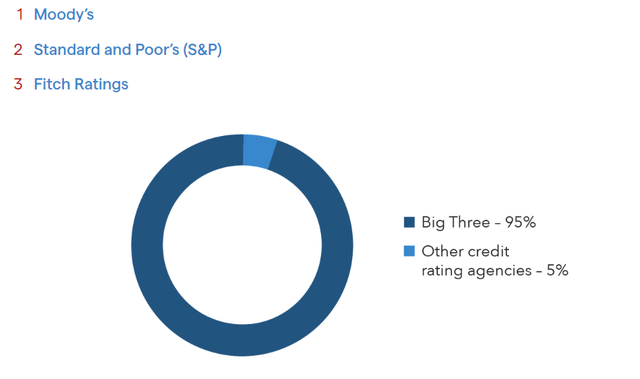
IG
The combination of a recognized brand, a near oligopolistic market structure, and a global operational footprint, along with the toll bridge moat in the industry and the portion of recurring revenue, positions S&P Global Corporation with a competitive advantage in the credit rating industry.
Financial Upside of S&P Global-IHS Markit Merger
In my view, the union of S&P Global and IHS Markit is a tactical initiative that boosts both revenue and cost synergies, broadening the scale and range of the unified business. IHS Markit, with its notable data offerings in the financial, resource, and transportation realms among others, meshes well with the operational framework of S&P Global, exhibiting common features such as high entry barriers and minimal capital reinvestment requirements for growth in tandem with global GDP. The financial outlook of the merger appears optimistic, with S&P Global forecasting $350 million in annual revenue synergies by 2026 and pinpointing $600 million in cost synergies from the merging of back-end operations and technologies. This consolidation not only expands S&P Global’s data capabilities but also ushers in new product lines and cross-selling opportunities, which, in turn, could bolster revenue channels. With an expected increase in earnings of around $1 billion compared to their standalone earnings, this merger aims to reinforce the enduring market-leading position of the merged entity across various sectors, envisioning a structurally expanded and financially more resilient business
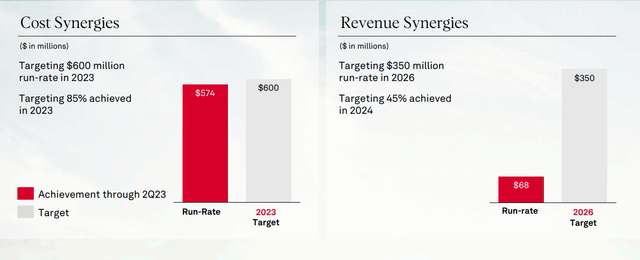
S&P Global Q2 2023 Investor Presentation
Financial Analysis
Over the past 5 years, the company has demonstrated consistent financial performance. Its revenue has shown a consistent and strong growth, increasing from $6,258.00 million in 2018 to $12,059.00 million in the last 12 months in 2023, representing a compound annual growth rate (CAGR) of approximately 14%. The earnings per share (EPS) has been grown steadily over the past 5 years, except for the last 24 months where we have seen macroeconomic pressures such as rising interest rates compress the operating margins of the business. As it stands today, EPS has been flat over the past 5 years, though I expect that EPS will continue to grow as interest pressures ease likely next year.
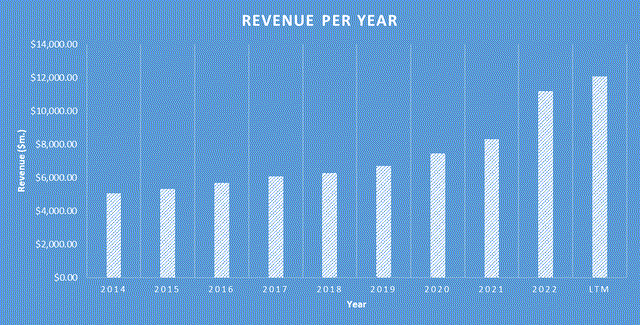
Author
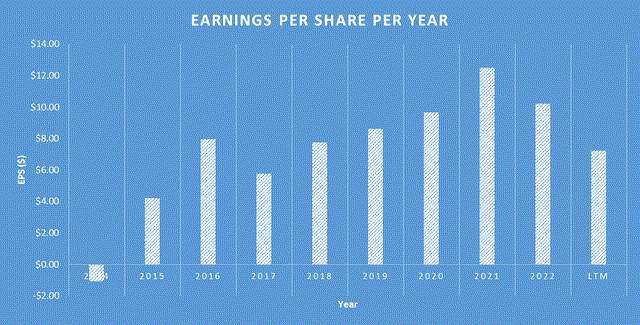
Author
As of the most recent quarter, the company reported cash and cash equivalents of $1,561.00 million. The company’s total debt stands at $10,676.00 million, a modest amount that can be repaid in around 3 years’ worth of free cash flow, reflecting the company’s responsible use of leverage. The company’s current ratio, a measure of its ability to cover short-term liabilities with short-term assets, is 0.78, which is not necessarily great as it is below 1, however given the liquidity that exists within the balance sheet and the profitability of the business, this should not be a concern in my opinion.
S&P Global has demonstrated a commendable capital allocation strategy with a focus on maximizing shareholder returns. A cornerstone of this strategy is their commitment to return 85% of free cash flow to shareholders, exemplifying their dedication to creating consistent and tangible value. The company’s approach towards dividends offers a clear testament to this intent. Since 2014, there has been a notable growth in the dividend per share, which started at $1.20 and has ascended to $3.50 in the Last Twelve Months (LTM). Another significant observation is the trend in the weighted average diluted shares outstanding. Up until 2022, there’s been a discernible downtrend, a likely result of share repurchases. However, the uptick in 2022 can be attributed to the merger with IHS Markit. With the merger now finalized, I anticipate a resumption in the downtrend of share count, supported by the company’s share buyback program.

Author
Valuation
When considering valuation, I always consider what we are paying for the business (the market capitalisation) versus what we are getting (the underlying business fundamentals and future earnings). I believe a reliable way of measuring what you get versus what you pay is by conducting a discounted cashflow analysis of the business, as seen below.
SPGI’s current LTM cash flow per share as of Q2, 2023 is $9.79. Based off the thesis mentioned within this article, I believe that SPGI’s cash flow per share should grow conservatively at 12% annually for the next five years. Therefore, once factoring in the growth rate by Year 5, SPGI’s Q2, 2028 cash flow per share is expected to be $17.26. If we then apply an exit multiple of 25, which is based off SPGI’s mean price to free cashflow ratio for the previous 10 years, this infers a price target in five years of $451.24. Therefore, based on these estimations, if you were to buy SPGI at today’s share price of $353.26, this would result in a CAGR of 5% over the next five years.

Author
Therefore, based on other opportunities available in the market, a 5% CAGR in the stock price does not seem sufficient, particularly when the U.S. 5-year treasury bond is yielding over 4%. Given these factors, SPGI will stay on my watchlist, as I hope the market will offer a more favorable investment opportunity in the future.
Conclusion
In my opinion, the credit rating industry in 2023 is influenced by diverse economic factors, mixing optimism with existing uncertainties. S&P Global (SPGI) with its well-known brand and broad global reach, appears poised for long-term growth and stability due to its oligopolistic market structure. The merger with IHS Markit is a notable step, likely to increase revenue, bring about cost synergies, and introduce new product lines, aiming for stronger market leadership. However, the projected 5-year stock price Compound Annual Growth Rate (CAGR) of 5% for SPGI seems less appealing when compared to the 5-year U.S. treasury bond yield of 4%. In my view, this comparison might prompt investors to weigh the relative growth and risk between SPGI’s stock and the safer return from a treasury bond, fostering a discourse on the financial attractiveness and risk management in the ever-evolving credit rating industry landscape.
Read the full article here


